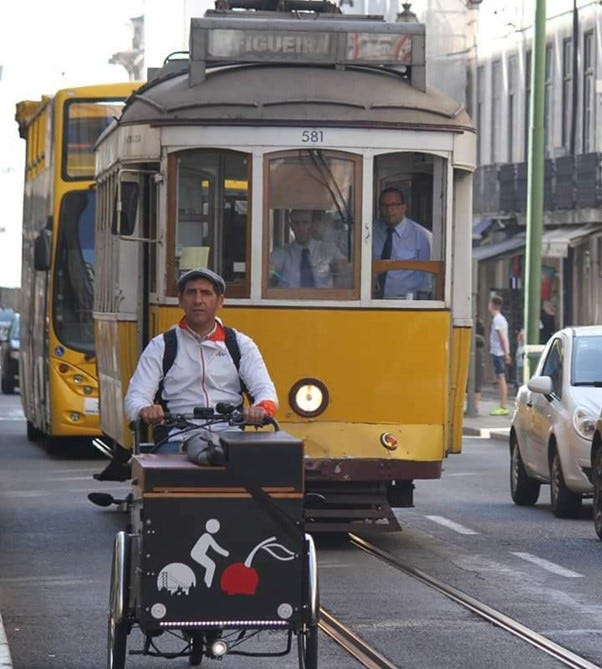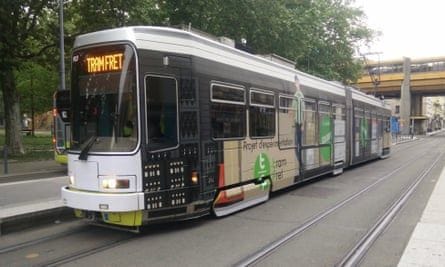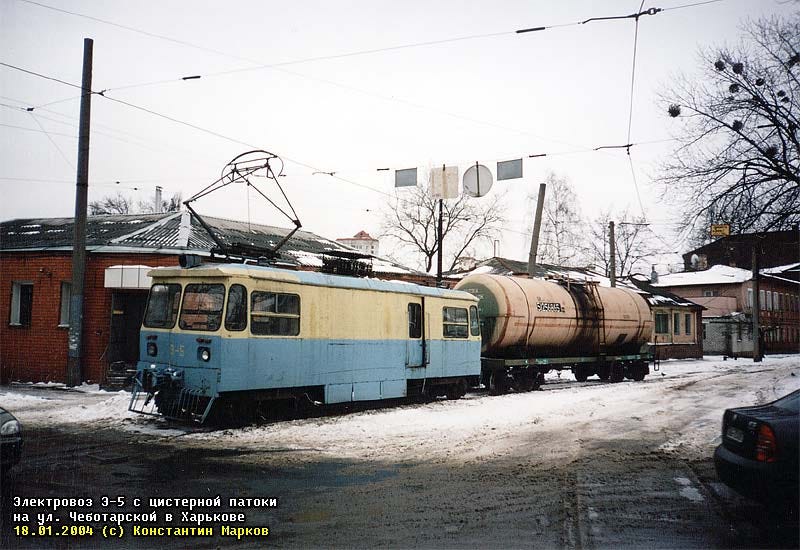I don’t know about your neighborhood, but mine is periodically choked with large trucks—almost all of them running on diesel—making deliveries. Massive 18-wheelers, double-parked outside dépanneurs (the word we use in Quebec for what the British call “cornershops,” and New Yorkers “bodegas”), unloading 12-packs of beer. UPS, Amazon, and FedEx trucks, whose drivers seem to view bike lanes—especially the paint-only ones—as their reserved parking zones.
When it comes to urban deliveries, especially in older cities like Montreal, whose centers are full of narrow, pedestrian-oriented streets, using a three-axle truck to unload cases of Labatt’s feels like classic Sledgehammer-to-Swat-a-Fly thinking. There has got to be another way…

And, of course, there is. In fact, a lot of other ways. In a previous Straphanger dispatch, In Praise of the Tiny Truck, I wrote about right-sizing, or fitting service vehicles—from funeral hearses to fire trucks—to compact urban neighborhoods. But an approach that few people seem to be aware of—and one that I love—is taking advantage of urban tram (or streetcar) networks to deliver freight.
It make all kinds of sense. If you have rail vehicles moving around a city on regular routes, why not use them to make deliveries? The city of Schwerin, in northern Germany, is a good example. It has a 21-kilometer, four-route system, which operates Bombardier Flexity trams. DHL, the international, Germany-based logistics and delivery company, has been using the trams to deliver up to 450 packages a day. According to this article in International Light Rail Magazine, the packages are loaded into wheeled containers, like the one in the photo below, and rolled directly onto the low-floor trams (it looks like the freight could ride alongside paying passengers).
Also in Germany, the city of Karlsruhe uses light-rail vehicles and "tram-trains" to carry consumer goods between city-center hubs. In the French city of St-Etienne, TramFret employs old trams to shuttle groceries and car parts (oh, the irony) around the city.
Not all such services are used for freight. For the last twenty years, Zürich, whose transit system is almost entirely built around trams, dispatches a “Cargo-Tram” and an “E-Tram” on regular routes around the city so citizens can dispose of bulky appliances, mattresses, and electronic waste.
One of the first of these systems was Dresden’s CarGoTram. The name referred to the fact that the bidirectional trams, each made up of five units, transported car parts from a road served logistics centre to Volkswagen’s “Transparent Factory,” operating along the same tracks used by passenger trams. (The service stopped running in 2020, alas, when a van crashed into one of the trams.)
Most of the cargo-tram services in France and Germany deliver packages and freight to depots where cargobikes—some of them electric, some human-powered—take care of the last-mile (er, last-kilometer) delivery to people’s doors. Makes a lot of sense to me. Why should a seven-tonne Mack or Freightliner truck be deployed on city streets to deliver cartons of milk and cigarettes, when a small fleet of emissions-free cargobikes can do the same job?
This isn’t a new idea, by the way. Before Los Angeles was the city of freeways, it was the metropolis of streetcars, the Big Red (interurban) and Yellow (local) Cars run by Pacific Electric. “By 1928,” writes Spencer Crump in his book Ride the Big Red Cars, “the company listed 2,628 freight cars among its assets…the rolling stock included 323 box cars, 444 flat cars, 67 gondolas, 10 stock cars, and 25 tank cars.” All running on electricity, supplied by overhead catenary wires, rather than diesel. The past, it turns out, can be surprisingly green.
One of the oldest systems was found in the city of Kharkiv, Ukraine. Starting in 1932 they used miniature electric locomotives (below) to move mainline freight wagons through the streets. I can’t imagine much is left of their urban rail system right now, alas.
Speaking of innovative solutions from the past, how about this one: the Canal-Trolley Boat. In the nineteenth century, extensive networks of inland canals were used to move freight around North America and much of Europe. Those canals still exist, though they are underused. Amazingly, in many places overhead catenary wires were strung over the canals, providing for low-cost, low-emission freight transport between ports and major cities. (This article on the Low Tech Magazine website gives lots of examples.)
For those who want to dig deeper, here’s a good round-up of cargo-tram services in Europe. Enjoy!









